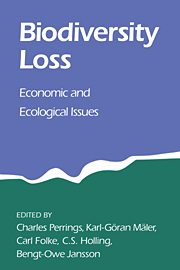Book contents
- Frontmatter
- Contents
- Foreword
- Preface
- List of contributors
- Introduction: framing the problem of biodiversity loss
- PART I CONCEPTUALISING DIVERSITY AND ECOSYSTEM FUNCTIONS
- 1 Diversity functions
- 2 Biodiversity in the functioning of ecosystems: an ecological synthesis
- 3 Scale and biodiversity in coastal and estuarine ecosystems
- PART II INTEGRATING ECOLOGY AND ECONOMICS IN THE ANALYSIS OF BIODIVERSITY LOSS
- PART III ECONOMIC ISSUES
- PART IV CONCLUSIONS
- References
- Index
3 - Scale and biodiversity in coastal and estuarine ecosystems
Published online by Cambridge University Press: 05 June 2012
- Frontmatter
- Contents
- Foreword
- Preface
- List of contributors
- Introduction: framing the problem of biodiversity loss
- PART I CONCEPTUALISING DIVERSITY AND ECOSYSTEM FUNCTIONS
- 1 Diversity functions
- 2 Biodiversity in the functioning of ecosystems: an ecological synthesis
- 3 Scale and biodiversity in coastal and estuarine ecosystems
- PART II INTEGRATING ECOLOGY AND ECONOMICS IN THE ANALYSIS OF BIODIVERSITY LOSS
- PART III ECONOMIC ISSUES
- PART IV CONCLUSIONS
- References
- Index
Summary
Introduction and summary
This chapter reviews coastal and estuarine ecosystems (with a special emphasis on the Chesapeake Bay) in terms of their unique biodiversity characteristics. Coastal and estuarine systems are generally low in species diversity. The exceptions are coral reefs and reefs that form on artificial structures. We attribute this to the general unpredictability of the estuarine environment. Reefs generally form in more predictable environments. An unpredictable environment selects for generalist species in order to cope with the unpredictable changes. In unpredictable terrestrial environments, ecosystems can build structure (i.e., trees and soil structure) to smooth out some of the noise and create a more stable base for increasing biodiversity. But estuaries are so dominated by the physical forces of water flow that these structures are impossible to build. Estuaries are characterised by their relatively small standing ecological structure and the high degree of organism mobility. All of these characteristics point to a high degree of ecosystem “resilience” (Holling 1986), and in fact we observe this high resilience in most estuaries.
We give a detailed description of the Chesapeake Bay and its watershed to help define these ideas and extrapolate them to the task of managing complex ecological economic systems. Biological or species diversity is put in a systems context as a scale-dependent measure of an important system characteristic, but one that may be inappropriate as a management focus in estuaries because of their special characteristics.
- Type
- Chapter
- Information
- Biodiversity LossEconomic and Ecological Issues, pp. 84 - 126Publisher: Cambridge University PressPrint publication year: 1995
- 17
- Cited by



